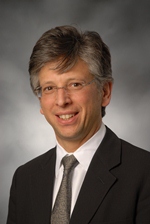Home > Press > ACS Nano editor-in-chief featured in article in MIT Technology Review
 |
| Paul Weiss, Ph.D., editor-in-chief of ACS Nano, is featured in an article in MIT Technology Review.
Credit: American Chemical Society |
Abstract:
Paul Weiss, Ph.D., editor of the American Chemical Society's (ACS') scientific journal ACS Nano, is featured in a profile in the September/October edition of MIT Technology Review. Founded in 1899 at the Massachusetts Institute of Technology (MIT), the magazine reports on important technologies and innovators. Weiss received a master's degree in chemistry from MIT in 1980.
ACS Nano editor-in-chief featured in article in MIT Technology Review
Washington, DC | Posted on September 3rd, 2013The article describes how Weiss, now professor of chemistry at the University of California, Los Angeles, and head of the California NanoSystems Institute, is bringing together nanoscientists and neuroscientists to develop new tools for understanding the brain. Weiss' efforts, the article points out, are bearing fruit.
In April, President Obama requested $100 million in federal funding for the Brain Research through Advancing Innovative Neurotechnologies (BRAIN) Initiative. Private research institutions are also chipping in. The Kavli Foundation, a nonprofit in Oxnard, Calif., has pledged $40 million over the next 10 years. "His profound understanding of the whole field of nanotechnology made a huge difference," the Kavli Foundation's Vice President of Science Programs Miyoung Chun, Ph.D., says of Weiss in the article. Chun helped coordinate the project that became the BRAIN Initiative.
Brian Crawford, Ph.D., president of ACS Publications, cited Weiss' accomplishments in advancing nanoscience through ACS Nano, which ACS launched in 2007, and is among more than 40 peer-reviewed scientific journals published by the world's largest scientific society.
"Under Paul Weiss' leadership, with an extraordinary team of editors and a thriving community of authors, reviewers, advisors and readers, ACS Nano is defining nanoscience and nanotechnology," said Crawford. "By working beyond traditional disciplinary boundaries, the journal is earning the attention of scientists, engineers, clinicians and the public."
Crawford pointed out that ACS Nano's "impact factor," a key measure of a publication's influence in the scientific community reported annually by Journal Citation Reports® from Thomson Reuters, reached a new record in 2012, rising above 12 for the first time. The impact factor is based on the number of times scientists cited ACS Nano articles in their research papers. That number totaled 38,585 in 2012, an increase of 70 percent from 2011.
####
About American Chemical Society
The American Chemical Society is a nonprofit organization chartered by the U.S. Congress. With more than 163,000 members, ACS is the world’s largest scientific society and a global leader in providing access to chemistry-related research through its multiple databases, peer-reviewed journals and scientific conferences. Its main offices are in Washington, D.C., and Columbus, Ohio.
For more information, please click here
Contacts:
Michael Bernstein
202-872-6042
Michael Woods
202-872-6293
Copyright © American Chemical Society
If you have a comment, please Contact us.Issuers of news releases, not 7th Wave, Inc. or Nanotechnology Now, are solely responsible for the accuracy of the content.
| Related News Press |
News and information
![]() Researchers develop molecular qubits that communicate at telecom frequencies October 3rd, 2025
Researchers develop molecular qubits that communicate at telecom frequencies October 3rd, 2025
![]() Next-generation quantum communication October 3rd, 2025
Next-generation quantum communication October 3rd, 2025
![]() "Nanoreactor" cage uses visible light for catalytic and ultra-selective cross-cycloadditions October 3rd, 2025
"Nanoreactor" cage uses visible light for catalytic and ultra-selective cross-cycloadditions October 3rd, 2025
Announcements
![]() Rice membrane extracts lithium from brines with greater speed, less waste October 3rd, 2025
Rice membrane extracts lithium from brines with greater speed, less waste October 3rd, 2025
![]() Researchers develop molecular qubits that communicate at telecom frequencies October 3rd, 2025
Researchers develop molecular qubits that communicate at telecom frequencies October 3rd, 2025
![]() Next-generation quantum communication October 3rd, 2025
Next-generation quantum communication October 3rd, 2025
![]() "Nanoreactor" cage uses visible light for catalytic and ultra-selective cross-cycloadditions October 3rd, 2025
"Nanoreactor" cage uses visible light for catalytic and ultra-selective cross-cycloadditions October 3rd, 2025
Interviews/Book Reviews/Essays/Reports/Podcasts/Journals/White papers/Posters
![]() Spinel-type sulfide semiconductors to operate the next-generation LEDs and solar cells For solar-cell absorbers and green-LED source October 3rd, 2025
Spinel-type sulfide semiconductors to operate the next-generation LEDs and solar cells For solar-cell absorbers and green-LED source October 3rd, 2025
![]() Rice membrane extracts lithium from brines with greater speed, less waste October 3rd, 2025
Rice membrane extracts lithium from brines with greater speed, less waste October 3rd, 2025
Grants/Sponsored Research/Awards/Scholarships/Gifts/Contests/Honors/Records
![]() Researchers tackle the memory bottleneck stalling quantum computing October 3rd, 2025
Researchers tackle the memory bottleneck stalling quantum computing October 3rd, 2025
![]() New discovery aims to improve the design of microelectronic devices September 13th, 2024
New discovery aims to improve the design of microelectronic devices September 13th, 2024
![]() Physicists unlock the secret of elusive quantum negative entanglement entropy using simple classical hardware August 16th, 2024
Physicists unlock the secret of elusive quantum negative entanglement entropy using simple classical hardware August 16th, 2024
Alliances/Trade associations/Partnerships/Distributorships
![]() Chicago Quantum Exchange welcomes six new partners highlighting quantum technology solutions, from Chicago and beyond September 23rd, 2022
Chicago Quantum Exchange welcomes six new partners highlighting quantum technology solutions, from Chicago and beyond September 23rd, 2022
![]() University of Illinois Chicago joins Brookhaven Lab's Quantum Center June 10th, 2022
University of Illinois Chicago joins Brookhaven Lab's Quantum Center June 10th, 2022
|
|
||
|
|
||
| The latest news from around the world, FREE | ||
|
|
||
|
|
||
| Premium Products | ||
|
|
||
|
Only the news you want to read!
Learn More |
||
|
|
||
|
Full-service, expert consulting
Learn More |
||
|
|
||








